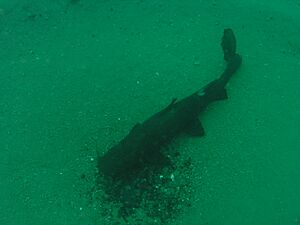Kampango facts for kids
Quick facts for kids Kampango |
|
|---|---|
 |
|
| Conservation status | |
| Scientific classification |
The kampango or kampoyo (Bagrus meridionalis) is a large, meat-eating bagrid catfish. It is found only in Lake Malawi, Lake Malombe, and the upper Shire River in Africa. This fish is critically endangered, meaning it's in great danger of disappearing.
The kampango likes to live near rocks in water that's not too deep, usually less than 50 meters (about 164 feet). But you can also find it in deeper areas, as long as there's enough oxygen. It also lives on sandy or muddy lake bottoms.
Appearance and Behavior
The kampango is one of the biggest fish in the Lake Malawi area. It can grow up to about 1 meter (3.3 feet) long, and some might even reach 1.5 meters (5 feet)! A common size is around 42 centimeters (1.4 feet). Female kampangos are usually bigger than males.
Adult kampangos are mostly black. Young kampangos are grey with dark spots. During the day, these fish hide in caves. But when the sun starts to set or rise, they come out to hunt. They mostly eat other fish called cichlids.
Reproduction and Life Cycle
When it's time to have babies, the male kampango digs a shallow nest in the sand, often near rocks. The female then lays thousands of eggs in this nest.
After the eggs hatch, the baby kampangos mostly eat special unfertilized eggs that their mother lays for them. Their father also brings them small invertebrates (like insects or worms) in his mouth. Both parents fiercely guard their eggs and young.
The young kampangos stay with their parents until they are about 12 centimeters (4.7 inches) long. However, many baby kampangos are eaten by other fish before they leave their parents. Some cichlids, like Mylochromis melanonotus and Pseudotropheus crabro, are known to steal kampango eggs and babies.
Interestingly, Pseudotropheus crabro also has a helpful relationship with the kampango at other times. It acts like a cleaner fish, eating parasites and dead skin off the kampango.
Another type of catfish, Bathyclarias nyasensis, is a brood parasite of the kampango. This means it tricks the kampango parents into raising its own young. Kampango parents have been seen taking care of entire groups of B. nyasensis babies as if they were their own! Scientists think that the B. nyasensis eggs hatch earlier than the kampango's own eggs and then eat them.
Not all fish are a threat. Some cichlids, especially Copadichromis pleurostigmoides, Ctenopharynx pictus, and Rhamphochromis, will release their own young near nesting kampangos. Both the kampango and cichlid parents protect this mixed group of babies. This teamwork helps more kampango young survive.
Kampango and Humans
People really like to eat kampango fish. They are caught using nets and, more often, fishing lines. They are mainly caught in deep water around places like Cape Maclear, Salima, Mbenje Island, and Nkhata Bay.
When fresh, kampango is often filleted (bones removed) and deep-fried. It can also be barbecued or cooked with tomato and onion. This is a traditional Malawian dish, often served with nsima, a type of thick porridge.
The kampango used to be a very common fish in its home waters. However, its numbers have dropped a lot because of overfishing. This means too many fish are being caught. Because of this, the IUCN (International Union for Conservation of Nature) now lists the kampango as critically endangered. Between 2006 and 2016, the number of kampango caught in southern Lake Malawi dropped by more than 90%. This shows how much their population has declined.


